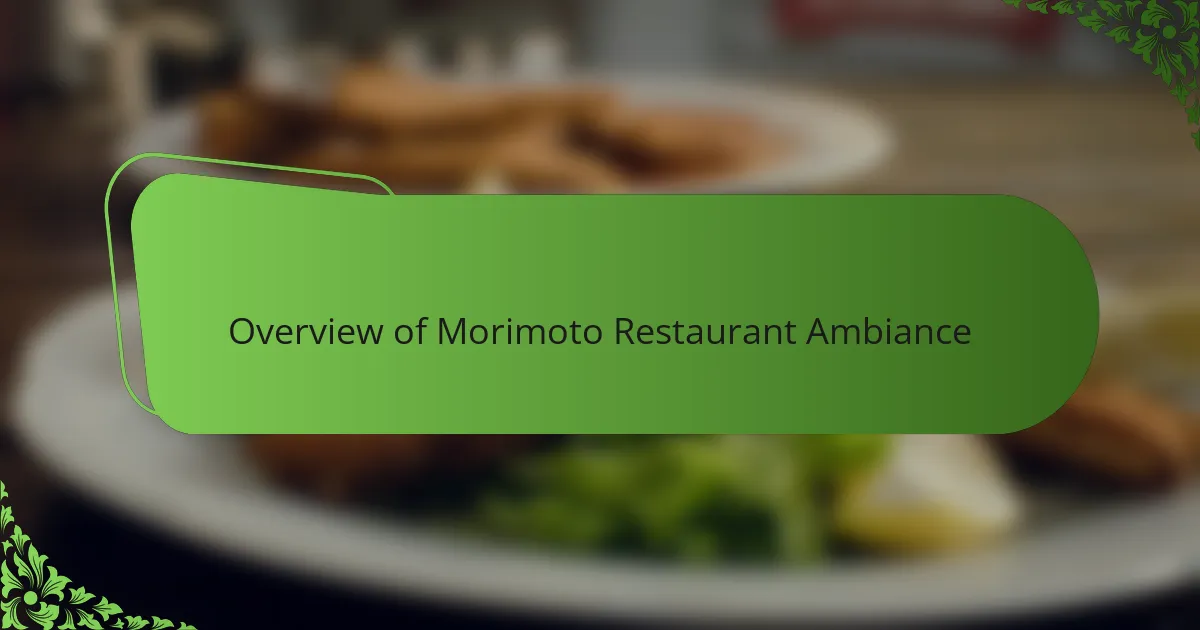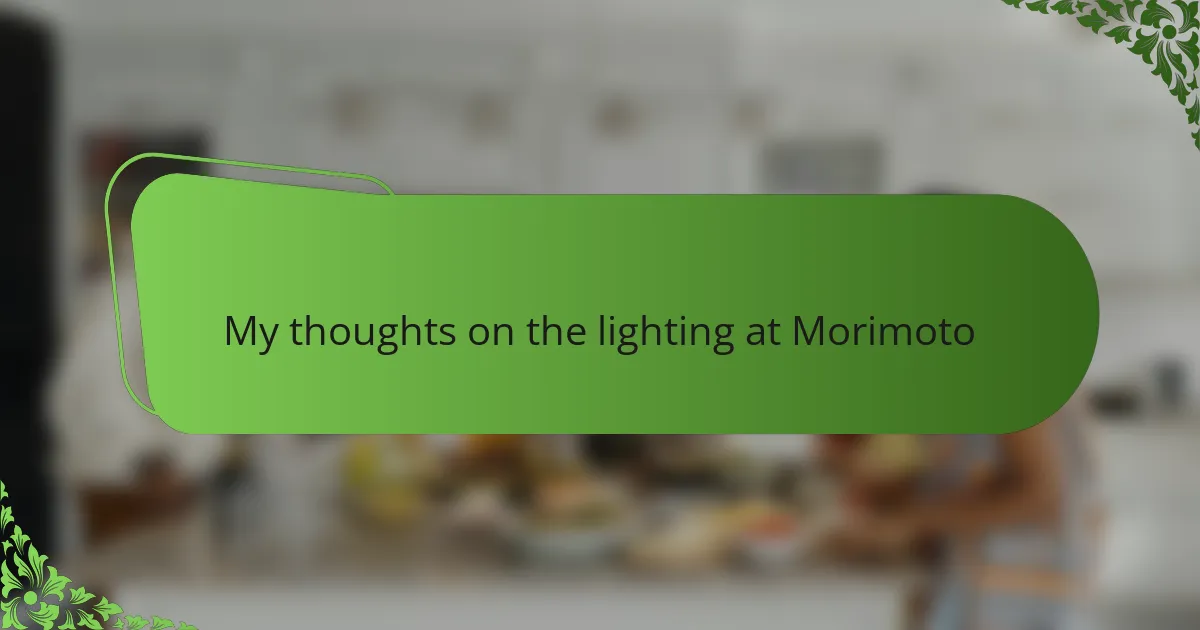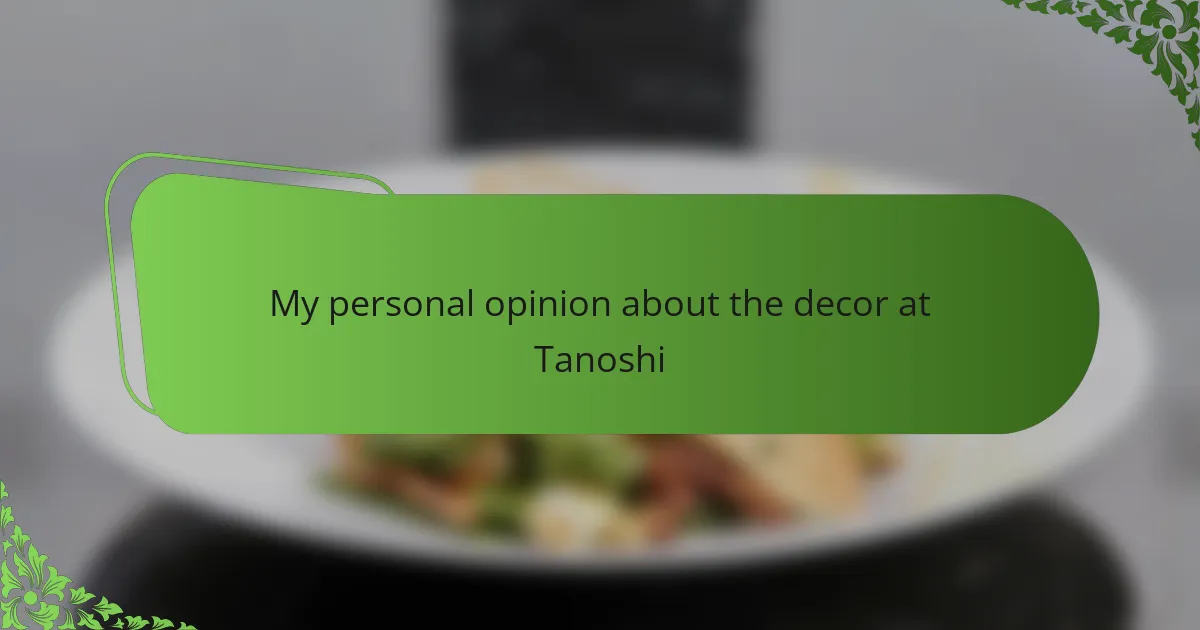Key takeaways
- Lighting in sushi restaurants enhances the dining experience by creating ambiance, showcasing food presentation, and inviting guests to savor their meals.
- Different types of lighting, such as ambient, task, and accent, work together to highlight the freshness and artistry of sushi.
- Morimoto restaurant exemplifies the effective use of lighting, balancing warmth and brightness to engage diners and elevate their appreciation of each dish.
- Thoughtfully curated lighting can transform the perception of food, making it not just visually appealing but also a memorable part of the dining experience.

Lighting in Sushi Restaurants
Lighting in sushi restaurants plays a crucial role in shaping the overall dining experience. Have you ever noticed how a softer, warmer glow can make the colors of fresh fish pop beautifully on the plate? From my experience, the right lighting not only enhances the presentation but also creates a cozy atmosphere that invites relaxation and enjoyment.
On the other hand, harsh or overly bright lighting can sometimes feel clinical, stripping away the intimacy that many sushi spots strive for. I remember a few visits where the lighting was so stark it almost distracted me from savoring the delicate flavors. It made me think: isn’t dining sushi about engaging all senses, including sight, in a harmonious way?
Good lighting balances clarity and ambiance, subtly guiding your attention to the craftsmanship behind each roll and slice. When the lighting complements the food, it feels like a carefully choreographed performance where every detail matters. Don’t you find that such lighting makes the meal feel more special and intentional?

Importance of Lighting for Dining Experience
Lighting sets the mood even before the first bite, don’t you think? I’ve noticed that when lighting is just right, it makes the dining space feel inviting and comfortable, almost like a gentle nudge to slow down and really savor the moment. This subtle influence plays a huge part in how enjoyable the meal becomes.
Sometimes, dim lighting can add a touch of mystery and elegance, making the experience feel more intimate and personal. I recall one evening when the soft glow made the sushi bar feel like a hidden gem, heightening my anticipation with every glance at the chef’s handiwork.
But lighting isn’t just about atmosphere—it’s about making the food look its best. Without proper illumination, even the freshest fish can appear dull, robbing the meal of its visual appeal. Have you ever been disappointed when your sushi didn’t look as vibrant as you expected? That’s why lighting matters so much to the whole dining experience.

Types of Lighting Used in Sushi Restaurants
When it comes to types of lighting in sushi restaurants, I’ve noticed a mix of ambient, task, and accent lighting working together. Ambient lighting creates the overall mood with a soft, even glow, while task lighting focuses light on the sushi bar, allowing you to see the chef’s precise knife work in action. Have you ever watched a sushi chef prepare your meal under just the right light? It’s almost like a live performance.
Accent lighting adds those subtle highlights that make the colors of fresh fish pop—think gentle spotlights or under-counter LEDs that bring out the reds, oranges, and whites on your plate. I’ve experienced how this type of lighting can turn even a simple roll into a feast for the eyes, making the anticipation almost as delicious as the first bite.
On the other hand, some places lean heavily on bright overhead fluorescents, which can feel less inviting. I remember one sushi spot where the harsh lights made the space feel more like a cafeteria than a dining experience—losing that special sushi vibe that draws you in. Isn’t it interesting how lighting types can completely alter your perception and enjoyment of a meal?

Overview of Morimoto Restaurant Ambiance
Morimoto’s ambiance strikes me as a delicate balance between modern sophistication and inviting warmth. The lighting subtly enhances this vibe—it’s neither too dim nor overly bright, creating an atmosphere where you feel both relaxed and engaged. Have you ever walked into a place that immediately feels just right? That’s the feeling Morimoto captured perfectly for me.
What stood out most was how the lighting highlighted the restaurant’s sleek design without overshadowing the food itself. Watching the chefs at work under gentle task lighting felt like being part of an exclusive show, where every detail mattered. It made me appreciate not just the taste but the artistry involved in each dish.
At times, the ambiance felt almost cinematic, with accent lights drawing out the rich colors on the sushi plates like jewels. I found myself pausing to appreciate the visual feast before even taking a bite. Don’t you think that when a restaurant’s lighting invites you to slow down and savor each moment, the whole dining experience becomes that much more memorable?

Analysis of Lighting at Morimoto
The lighting at Morimoto struck me as thoughtfully curated—soft enough to create intimacy, yet bright enough to reveal every detail on the plate. I remember noticing how the gentle task lights above the sushi bar made the fresh fish gleam almost like precious gems, which for me deepened the appreciation of the chef’s craft. Isn’t it remarkable how such attention to lighting can elevate what could otherwise be routine dining?
What I found especially compelling was how the balance between warm ambient light and strategic accent lighting avoided any sense of harshness. It never felt clinical or disconnected; instead, it felt like the lighting was inviting me to engage fully with both the space and the meal. Have you ever been in a restaurant where the light actually made you pause and admire your food before tasting it? That was exactly my experience at Morimoto.
Occasionally, I noticed subtle shifts, like a spotlight gently illuminating the texture of a cut, which reminded me of watching an art exhibit under perfect lighting. These little touches aren’t accidental—they show real care in crafting a multi-sensory experience. Doesn’t that attention to detail make a difference in how you remember a meal? For me, it certainly made Morimoto stand out.

Impact of Lighting on Food Presentation at Morimoto
The way Morimoto uses lighting to showcase its dishes truly caught my attention. I recall once watching a piece of toro illuminated just right—the soft glow made the marbling look almost mesmerizing, like an edible work of art. Have you ever noticed how the right light can almost make you taste freshness with your eyes first? That’s the kind of sensory layering Morimoto manages effortlessly.
It’s not just about making the food look good; the lighting shapes how you emotionally connect with each bite. I found myself lingering over the presentation longer than usual, as if the light invited me to slow down and appreciate the chef’s skill behind every slice. Doesn’t it feel like the atmosphere itself becomes part of the meal when lighting enhances the food so thoughtfully?
Then there are those subtle moments when accent lights highlight textures—the way a seared edge glistens or how the translucence of a slice hints at perfect freshness. For me, these details transform sushi from mere food into an experience, and Morimoto’s lighting is the unsung hero making that transformation possible. Have you had a dining moment where the lighting made the food not just seen, but truly felt? That’s the magic here.



